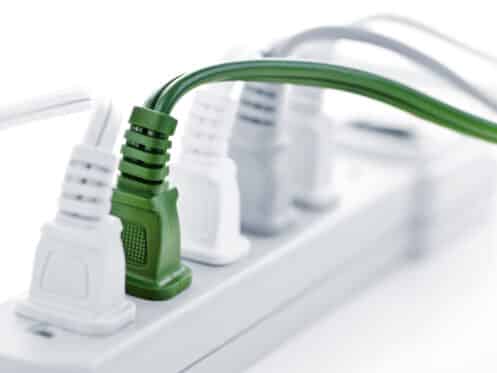Surge protectors are important for preventing damage and protecting all of your sensitive electronic devices. Power strips can also be useful for allowing you to plug in extra things when not enough outlets are available. However, it is important to understand that the two aren’t the same thing. In this article, we’ll explain the difference between the two and also show you how whole-home surge protection can keep your home and electronics even safer.
Power Strips vs. Surge Protectors
It’s always a good idea to plug sensitive and/or expensive electronics like TVs, computers and stereo equipment into a surge protector. Power surges occur when the voltage flowing through an electrical system or a specific electrical circuit suddenly spikes for some reason. In the US, home circuits run on either 120-volt or 240-volt power. A power surge can lead to the current spiking into well over a thousand volts, which can easily burn out components like control boards, computer chips and microprocessors.
Surge protectors prevent this type of damage by “clamping” whenever the electricity flowing to them spikes above a set voltage. Clamping means that it stops the power from continuing to flow downstream (i.e., to whatever is plugged into the surge protector). All surge protectors have a specific clamping voltage, which is how many volts it takes for them to activate and stop the power from flowing downstream. This can range anywhere from 330 to 4,000 volts. The lower a surge protector’s clamping voltage is, the better protection it provides since it will activate even if there is only a minor surge.
While using surge protectors is important, the problem is that many people mistakenly believe that any power strip is a surge protector since the two look similar. This isn’t true, as standard power strips are essentially just extension cords that provide extra outlets without any surge protection. The only real way to tell the difference between the two is to look at the strip and see if it has a maximum joules rating, which is something you’ll only find on surge protectors.
The joules rating tells you the maximum amount of power that a surge protector can handle before it fails. Most surge protectors are robust enough to handle multiple smaller power surges before they give out and stop working. Many surge protectors are rated to handle 2,000 joules. Once the surge protector has been exposed to more than 2,000 joules of energy, it will stop working, and your electronics will no longer be protected. This can sometimes happen with just one major power surge. However, every power surge will diminish the amount of protection the device provides and essentially subtract from the maximum joules it can handle. This means that a surge protector will also eventually stop working after a certain number of more minor surges depending on how high the voltage spikes with each surge.
Surge Protector Strips vs. Whole-Home Surge Protection
While surge protector strips are useful and should definitely be used for all sensitive electronic devices, they will generally never protect against a major external power surge. Instead, they are meant to protect against internal power surges that originate inside a home’s electrical system. External power surges originate in the electrical grid and can happen due to lightning strikes, blown transformers, downed power lines and various other issues. This type of surge is far more powerful than an internal surge and can lead to more than 10,000 volts of electricity surging into your home.
A major external power surge will almost always exceed the maximum joules rating of even the best surge protector strip and lead to it failing and not protecting your electronics. An external power surge also has the potential to cause a fire or seriously damage your electrical system and wiring. Any time there is an extreme spike in the voltage flowing through an electrical wire, it leads to the wire almost instantly overheating and possibly starting to melt.
If a major external power surge hits your home, it can easily cause more than $10,000 worth of damage. You’ll usually be looking at needing to repair or replace many of your major appliances, including your furnace, air conditioner, dishwasher, washing machine, etc. Most of your sensitive electronics will also get fried and need to be replaced, and you’ll also typically have to replace at least some outlets, light switches and light fixtures. The only way to protect against extensive damage from an external power surge is to stop the surge before it enters the home and flows into its electrical system, which is exactly what whole-home surge protectors are designed to do.
How Whole-Home Surge Protection Works
A whole-home surge protector is always installed in between where the wire from the electrical grid connects to the home’s main electrical panel. This allows it to detect if the voltage suddenly spikes and almost instantly redirect all of the excess power away so that the surge doesn’t flow into the electrical system. Instead, the surge protector activates and sends the excess current into the home’s grounding rod where all of the electricity then safely disperses into the soil.
The best whole-home surge protectors have a clamping voltage of 400 volts or less. As with standard surge protectors, the device will automatically activate within a few milliseconds to prevent the excess current from continuing to flow. Most quality whole-home surge protectors are also rated to withstand surges of up to 20,000 volts. This means that it will offer protection against the vast majority of external power surges. The surge protector could fail and not protect against a direct lightning strike to your home since a bolt of lightning can contain well over 100,000 volts, but the chances of lightning striking your home are extremely small.
One thing to understand is that a whole-home surge protector won’t actually shut off the flow of electricity into the home; it channels the excess voltage away. The amount of voltage that it lets through is typically never high enough to damage your electrical system, but it could be sufficient to cause some damage to sensitive electronic devices. This is why experts recommend still using surge protector strips along with a whole-home surge protector since they will provide an extra line of defense for your electronics.
As with surge protector trips, a whole-home surge protector can only withstand so much electricity before it will no longer work. This means that you will usually need to have the surge protector replaced if your home is ever hit by a large external power surge. However, the cost of replacing the surge protector will be far less than what you’d need to pay if you didn’t have whole-home surge protection.
If you want to ensure that your home is fully protected against power surges, Hunt’s Services is ready to help you upgrade to whole-home surge protection. Our highly skilled, licensed electricians specialize in surge protector installation. We can also help if you’re looking to install an EV charging station or whole-home generator or if you need any other electrical installation services. Our team also specializes in all electrical repairs, and we’re also the top choice in Tacoma and the Puget Sound area for plumbing, heating and air conditioning. To learn more about the benefits of a whole-home surge protector or to schedule an appointment to install one at your home, contact us today.




